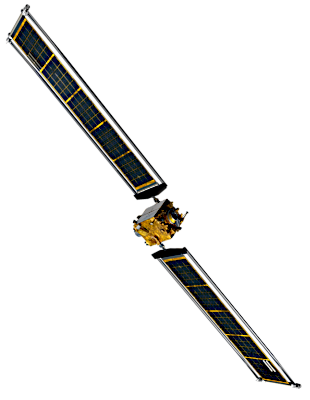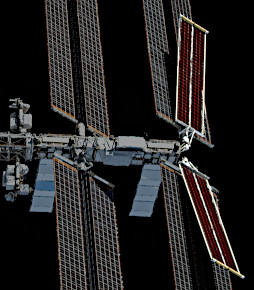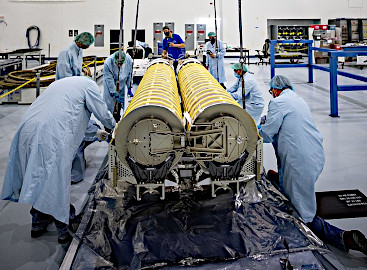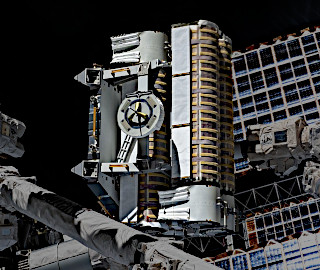
iROSA is attached to the Integrated Truss Structure [ITS] - Port 6 Truss Segment.


iROSA is attached to the Integrated Truss Structure [ITS] - Port 6 Truss Segment.

Roll Out Solar Array (ROSA) is a lightweight, flexible power source to be deployed and used in space. It was designed and developed by Redwire Corporation, a U.S. aerospace manufacturer and space infrastructure technology company.

A larger version, called the ISS Roll Out Solar Array (iROSA), has been developed specifically to supplement the existing ISS arrays.
Traditional solar panels used to power satellites and stations are bulky, with heavy panels folded together using mechanical hinges. ROSA is twenty percent lighter, 325 kg, and one-fourth the volume of rigid panel arrays with the same performance.
ROSA is a flexible solar array that rolls out like a measuring tape unwinds on its spool. The new design rolls up to form a compact cylinder for launch with significantly less mass and volume. This offers substantial cost savings and allows an increase in power for satellites.
ROSA has a center wing made of a flexible material which support the strings of photovoltaic cells that produce electricity. Both the sides of the wing have a narrow arm that extends through the length of the wing to provide support to the array. These arms, called a high strain composite booms, look like split tubes flattened and rolled up lengthwise.
Deployment of the wings uses mechanical energy rather than motorized power. As each boom transitions from a coil shape to a straight support arm it uses the stored potential energy to push out the end of the wing.
References: Wikipedia - Roll Out Solar Array

The Double Asteroid Redirection Test (DART) mission uses ROSA technology to power its solar electric propulsion. DART is a NASA mission to test planetary defense against near-Earth objects (NEOs). It was launced in November 2021 and in 2022 will deliberately crash into moon Dimorphos of double asteroid Didymos. This will assess how an impact may deflect an asteroid on a collision course with Earth.
DART will be the first probe to fly the new arrays, paving the way for their use on future missions.
References: Wikipedia - DART
The Lunar Gateway is a planned small space station in lunar orbit intended to serve as a solar-powered communication hub, science laboratory and short-term habitation module. It is a multinational collaborative project involving NASA, ESA, JAXA, and CSA. It is planned to be both the first space station in deep space and the first to orbit the Moon.
ROSA arrays are planned to be used on the Power and Propulsion Element of the Lunar Gateway.
References: Wikipedia - Lunar Gateway
The photovoltaic cells on the existing Solar Array Wings of the ISS were designed for a 15-year service life. This has been exceeded by a number of arrays resulting in noticeable degradation and loss of efficiency.

To augment the older arrays, three pairs of scaled-up versions of ROSA, known as iROSA, are planned by NASA to launch from June 2021 to late 2022. The SpaceX Dragon 2 cargo spacecraft is used to carry iROSA to the ISS.
The iROSA arrays are attached to the mast cans of the existing array wings and deployed along their central part.
NASA first tested the ROSA technology in vacuum chambers on Earth. In June, 2017 a ROSA test mission was launched to the ISS aboard SpaceX CRS-11. Engineers on the ground remotely operated the ISS Canadarm2 to extract the ROSA test array from the SpaceX Dragon craft.
ROSA was unfurled and extended by tensioning booms on both sides of the 1.6-meter-wide wing. NASA conducted continuous tests for a week and observed the behavior of the solar array as it was exposed to extreme temperature swings through the ISS's orbit. Vibrations were mechanically introduced to assess the array's response to structural loads.
Subsequent to the experiments, ground controllers were unable to lock the solar panel in its stowed configuration. The solar array was therefore jettisoned from the ISS and destroyed.
In February 2021 ISS crew installed support brackets for iROSA on the ITS P6 truss mast cans. These cans hold the existing Solar Array Wings.
In June 2021, two new solar iROSA panels were installed on these brackets. The two operations took six hours each to complete and were carried out on three spacewalks by astronauts.
The new arrays are intended to give the station a total of 120 kilowatts of additional augmented power during daytime orbit.
Further iROSA assemblies are due to be installed on the ISS during 2022. One of them is planned for the ITS P4 Truss.

